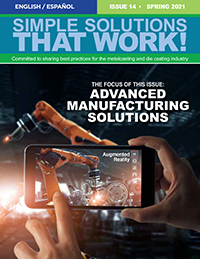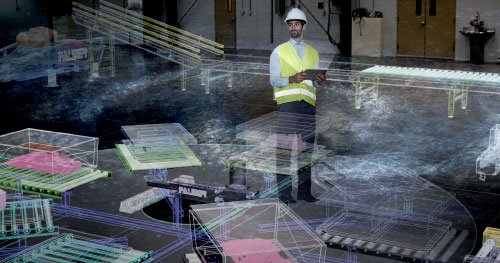Foundry & industrial processing Machinery EQUIPMENT & SYSTEMS
U.S. & Canada Call 1.800.457.5456
Fear and Loathing in Las Manufacturing
Home Articles Fear and Loathing in Las Manufacturing

Simple Solutions That Work!™, Volume 14, April 2021
Written - Jack Palmer
Jack Palmer
President
Palmer Manufacturing & Supply, Inc.
Article Takeaways:
The only constant is change: What makes us so afraid?
Way before molten metal was poured, we were hunters and gatherers that lived in constant fear. We were afraid of anything that wasn’t familiar – another tribe, a wild animal, an unfamiliar food and on and on. Fear was a good thing because quite simply, it kept us alive and forever became hard wired into our DNA.
But it's the 21st century – and yet, fear is still what keeps many businesses from moving forward. This time however, the fear is for different reasons, as once you remove the thin veneer of civilization, we are still pretty simple animals and do whatever it takes to survive.
While our challenges now for survival are quite different – we are still fearful almost every day. In business, making payroll, meeting deadlines and keeping the ship running consumes us on a daily basis. While these threats are not as direct and onerous as our cave dwelling / hunter gatherers; they are still very real.
Fear in business is still one of the driving forces that controls our actions and inactions.
Doing nothing is sometimes thought to be the prudent course when unsure about a decision regarding a major purchase or new technology. Waiting may sometimes be the correct path but with the speed of today's technology doing nothing can be the kiss of death. Businesses simply have to keep up or get left behind.
Whereas the status quo appears nice and neat, change is not. Change is constant and comes in all forms and levels. A wise man aptly said... "there is nothing permanent except change." Sand reclamation gained attraction due to the high cost of sand as a result of fracking. Nothing provokes change faster than immediate bottom-line considerations!
Trying out new materials due to regulations is 'required' change. At the highest level there are irreversible, disruptive changes – 3D printing would certainly be in this category.
There are all kinds of foundries in operation today from high-speed automated global foundries to jobbing foundries and everything in between. There are foundries that have been in operation over 100 years with generations of the same family. When you walk through those foundries, you see ancient buildings that have been altered through the years but where you can still see the original footprint. These carved out buildings hold quite a successful history – however, 2021 presents new challenges that requires the ability to dare to do things differently. The "if it ain't broke" mentality will not work moving forward. All businesses need continuous improvement as without it you will start a slow decline. We all know dozens of foundries that are no longer with us perhaps for this reason.
North American foundries are competing with the whole world. Profit margins are thin making even small mistakes extremely costly, not even to mention the high cost of having production come to a halt. All of this makes understanding and expecting change even more paramount. Why is it that some companies fight and fear change, or hope it will go away, whereas others will expect, accept, and embrace it?
What kind of investor are you?
We generally see two different types of investors; those that expect change and are anxious to learn newer ways to do things and can 'see it,' 'and those rooted in the past, that look for ways to say that 'it won’t work here.' 'The only difference between them is the fear factor. The fear of being wrong is so pervasive that it prevents people from doing any kind of intelligent evaluation.
Change is so easy to avoid – and that’s precisely what makes it so hard. It's much easier to put off doing ANYTHING than it is to tackle something complicated. Furthermore, if you take it on, you run the risk of being wrong. Funny how a manager could make tens of thousands of great decisions throughout the year, but then try something new and have it not go as well as planned – that manager is forever known for the one that didn’t go well. When that happens, the repercussions of being wrong takes on a whole new meaning and can negatively affect future decision making. We see this in a set of predictable excuses that we hear day-in and day-out:
"We're going to hold off on that decision to become a more productive operation, and..."
...wait until the end of the year
...see what happens after the election
...wait until COVID-19 is under control
Then during the initial conversations, whereas those that expect change will only concentrate on productivity measurements, those rooted in the fears from the past will fire out these questions: How much is it? (No matter the price or productivity gains—the response is always "it's too much."), and Can you change it to make it, bigger, faster, more functions etc. (Interesting that its fairly common to make new requests on technology never seen before.)
I look back on the number of foundries that we converted to no-bake and marvel at their decision-making skills to make such an investment. In all cases I see a simple process of research, documentation and realistic production projections. When you have the right mindset, people and tools to do a proper evaluation, change becomes easy, quantifiable, verifiable, and profitable.
Think about which investor you are and what you really need to do a proper evaluation and the set of questions you need to ask that will help you with your research.
Talk with your operators
Think about your own shop. Do you foster fear by not discussing changes or opportunities with your staff? The thought of losing a job, or being rejected (especially in front of others), forces many operators to remain silent and when that happens, the vicious cycle of fear continues and grows.
We recently did a foundry floor layout in virtual reality and did it exactly as the manager wanted it done. Then we did another layout that was different, but inspired by their operators. The minute the operators entered the environment, the manager realized that his original layout was not the correct one for their production needs and that his operators had designed a much better layout. No one knows the foundry floor better than your operators. You really want their honest input on changes to the floor, whether you are adding automation or simply changing the conveyor lines. Our production staff is responsible for many of our equipment innovations and improvements, and many of their ideas came from discussions on the production floor.
Anyone who has read The Goal understands the importance of identifying bottlenecks, and the value of getting buy-in from your operators’ to successfully manage continuous improvement.
There is a marked difference in the decision-making processes of the old grey haired crowd vs people in their 30's or younger. The 30 somethings grew up with technology and are very comfortable with it. The older guys... not so much. The reason is simple – fear; they are simply afraid of something they don’t completely understand.
The lesson here is to listen to your younger team as they know your production challenges and are very comfortable using and trying new evaluation tools and technologies. They expect and embrace change and are versed in using technologies such as virtual and augmented reality and understand the latest in 3D software, and enterprise tools such as SAP. Surround yourselves with good people and then give them the room to research, document and develop projections – to eliminate the fear-factor.

Remove limitations
As an almost 50-year-old global equipment manufacturer, we like to think of the glass as half full at all times because we see opportunities literally everywhere. We see smaller things like reducing sand degradation to larger things like complete automation with RFID tags. We love 3D printing as much as we love designing mixer blades that last longer. In our culture, we see all of these productivity tools as the same, as they are all saving time and money while producing something better.
We weren't always this way; this is truly an evolution. Years ago, we described ourselves as a North American jobbing foundry equipment manufacturer. What a horrible way to limit ourselves. How did we evolve? By listening to our customers, we gradually built bigger and better equipment, for bigger global customers, that had even bigger molds and cycle times. Therefore, we grew…and learned an important lesson to not limit ourselves! Getting rid of the 'limiting factor' opened our eyes up to developing more industry’s firsts including this—our own publication!
Our history is pretty unique – we started as a foundry (which still operates today). Therefore, we had the same fears that many of our customers have today. We are foundrymen making machinery; not machinery makers making foundry machines. We have fought our customers' fears from our beginnings.
Take a look around your shop; do you limit yourselves or limit your people? If so, why? What are you afraid of?
Summary
Especially in the last 5 years, we see a new set of fears – in the revolutionary technologies entering the foundry floor. Additive manufacturing, robotic work cells, smart technologies, 3D scanners, and Industrial 4.0 has caused everyone to rethink how to make quality castings. There is so much to look at – that those with a serious case of fear-factor are jumping for cover. And while there are some that wonder if it is even possible to eliminate fear from the workplace – I am not one of them.
We can all be considered explorers, not of land, sea and space, but of technology. If you look at where we were just 15 years ago compared to now, the difference is absolutely astounding. Imagine what the next 10 – 50 years will bring!
Can you think of a more important time to shed your limiting and fear factors to embrace change?
Copyright © 2025 Palmer Manufacturing & Supply, Inc. | Terms and Conditions | Privacy Policy




